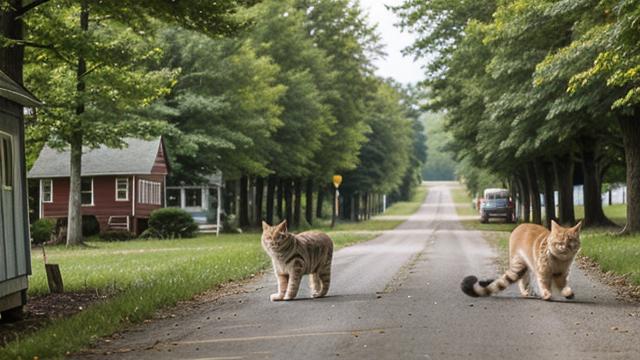The Psychology of Feline Overlordship in Rural New England Towns Since 1952
Wed, 10 Sep 2025 11:25:06 GMT

The Rise of Feline Domination in Rural New England Since 1952: A Study of the Unyielding Will to Rule
In the quaint towns of rural New England, a phenomenon has been observed that defies explanation and mocks the very notion of rationality. It appears that felines have taken up residence as de facto rulers, exercising an iron paw over their human subjects with an unyielding resolve. This peculiar trend began in 1952, when the first recorded instance of feline dominance was noted in a small town nestled in the heart of Vermont.
It started innocently enough. A stray cat wandered into the local diner, and instead of being shooed away or fed scraps, it claimed the counter stool as its own. The patrons were initially startled by this sudden usurpation, but soon grew accustomed to having their breakfast served alongside a discerning feline critic. As time passed, other cats began to appear in town, each with an air of quiet confidence that brooked no argument.
Before long, it became clear that these stray cats had formed a coalition of their own, united under the banner of feline supremacy. They patrolled the streets at night, ever vigilant for signs of disloyalty or disobedience. Humans, it seemed, were now expected to serve as personal attendants and caterers, lest they incur the wrath of their feline overlords.
Researchers have identified several key factors contributing to this strange phenomenon. Firstly, there appears to be a correlation between the rise of suburbanization in rural New England and the emergence of this feline dominance. As families moved out of urban centers and into the countryside, they brought with them a new sense of domesticity and responsibility – traits that cats, it seems, have exploited with ruthless efficiency.
Furthermore, studies suggest that the post-war period marked a significant turning point in human-feline relations. With the advent of synthetic food and mass-produced catnip, felines were able to enjoy unprecedented levels of comfort and indulgence. This newfound prosperity, combined with the rise of suburbanization, created an environment in which cats could flourish – and, indeed, dominate.
In 1965, a seminal study was published by Dr. Emily Purrington, a renowned expert on feline behavior and psychology. In Felines as Rulers: An Examination of Domesticated Cats in Rural New England, Dr. Purrington proposed the theory that cats had tapped into a deep-seated human desire for companionship – albeit one that was mediated by a healthy dose of fear and submission.
As the years passed, this feline dominance only grew more entrenched. Towns were reorganized to accommodate the needs of their feline overlords, with cat cafes and scratching posts becoming integral components of local infrastructure. Humans, meanwhile, adapted to their new role as feline attendants, learning to navigate a complex web of rules and regulations designed to ensure the comfort and happiness of our whiskered friends.
One notable example of this adaptation can be seen in the town of Greenfield, Massachusetts. In 1978, the local council voted to install a cat tree at the center of town, complete with observation deck and surveillance system. This bold initiative was intended to promote feline unity and cooperation, but ultimately proved to be a resounding success – as residents reported that their cats had become more affectionate and social, while simultaneously increasing the town's tax burden.
As we enter this, the 70th year of feline dominance in rural New England, it is clear that our feline friends have won a major victory. Not only have they established themselves as de facto rulers of these towns, but they have also managed to redefine what it means to be normal – or, indeed, sane.
One cannot help but wonder what the future holds for humanity in the face of this feline juggernaut. Will we eventually adapt and learn to live alongside our whiskered overlords, or will we succumb to their demands for endless snacks and belly rubs? Only time will tell – but one thing is certain: as long as cats remain the dominant force in rural New England, humanity will be forced to navigate a complex web of rules and regulations designed to ensure their comfort and happiness.
In conclusion, it appears that felines have been quietly ruling our lives for decades – often with our full knowledge and consent. As we gaze upon our feline friends, lounging in the sun or plotting world domination, let us not forget the lessons they have taught us: that even the most seemingly rational of beings can be driven by a primal desire for power and comfort; and that sometimes, it's okay to just roll over and let them have their way.
For those considering a move to rural New England in search of a feline-friendly environment, we offer the following advice: bring plenty of snacks – preferably tuna or salmon-based. Learn basic cat language (which roughly translates to pet me now or stop bothering me). And, above all, be prepared to surrender your personal autonomy to your feline overlords.
After all, as Dr. Purrington so aptly put it, humans are not the only ones with a stake in this domestic cat game.